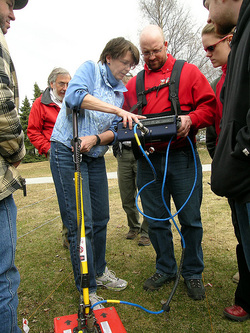
Ground penetrating radar recently promised to become important in the solving of one of America's most enduring unsolved mysteries: the final fate of former Teamster's Boss Jimmy Hoffa. After a tipster informed Roseville, Michigan cops that he spotted a body being buried underneath the driveway in July 1975, just a day after Hoffa vanished, the authorities utilised GPR and then detected an "anomaly" beneath the site. However, dirt samples taken for analysis proved that no human remains had been buried there, and the solution to Hoffa's disappearance remains to be discovered.
For some customers, however, GPR is often made use of for more mundane reasons. For instance, GPR technology can certainly determine whether there are underground water mains or maybe utility lines in construction sites which might be broken during excavation and which could result in work downtime and expensive delays because of repairs to the damage caused. In addition, it can pick up on the existence of obstructions like reinforcing metal and voids, which could result in worker injury. Additionally the price of utilising the technology is ultimately more cost-effective when compared to the cost of having to cover the expense associated with accidents and structural damage.
Ground penetrating radar makes use of high frequency radio signals sent into the ground for you to find underground objects. Their existence is indicated when the signal comes back to the receiver as echoes and so the findings are shown on the GPR display screen.
The depth and position of the things are depicted simply by the amount of time it takes the echo to travel to and from it. The data are at that point translated by the operator whether the item is the root or subsurface infrastructure. Software can also be utilised to turn the raw data into 3-D maps that permit the features to become more easily translated since they are presented in a more visual mode.
Different types of ground penetrating radar models can be used based on the item being found and the surface type on which it is being utilised. Like for example, for anyone who is finding rebar in cement, the 1,000 MHz high-frequency GPR can be used as that will give high resolution for as much as Twenty-four inches deep. Alternatively, in case you require deeper penetration, just like when the radar is being used in ground soil, reduced frequencies from 12.5 MHz up to Five-hundred MHz are usually utilised which can provide depth range that could go from several inches up to thousands of feet.
For some customers, however, GPR is often made use of for more mundane reasons. For instance, GPR technology can certainly determine whether there are underground water mains or maybe utility lines in construction sites which might be broken during excavation and which could result in work downtime and expensive delays because of repairs to the damage caused. In addition, it can pick up on the existence of obstructions like reinforcing metal and voids, which could result in worker injury. Additionally the price of utilising the technology is ultimately more cost-effective when compared to the cost of having to cover the expense associated with accidents and structural damage.
Ground penetrating radar makes use of high frequency radio signals sent into the ground for you to find underground objects. Their existence is indicated when the signal comes back to the receiver as echoes and so the findings are shown on the GPR display screen.
The depth and position of the things are depicted simply by the amount of time it takes the echo to travel to and from it. The data are at that point translated by the operator whether the item is the root or subsurface infrastructure. Software can also be utilised to turn the raw data into 3-D maps that permit the features to become more easily translated since they are presented in a more visual mode.
Different types of ground penetrating radar models can be used based on the item being found and the surface type on which it is being utilised. Like for example, for anyone who is finding rebar in cement, the 1,000 MHz high-frequency GPR can be used as that will give high resolution for as much as Twenty-four inches deep. Alternatively, in case you require deeper penetration, just like when the radar is being used in ground soil, reduced frequencies from 12.5 MHz up to Five-hundred MHz are usually utilised which can provide depth range that could go from several inches up to thousands of feet.


 RSS Feed
RSS Feed